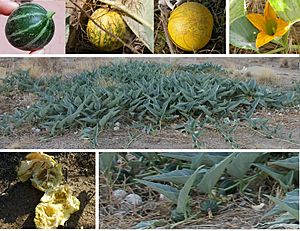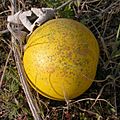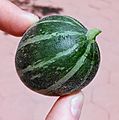Cucurbita foetidissima facts for kids
Quick facts for kids Cucurbita foetidissima |
|
|---|---|
 |
|
| Buffalo gourd plant, male flower and fruits. | |
| Conservation status | |
| Scientific classification | |
| Genus: |
Cucurbita
|
| Species: |
foetidissima
|
| Synonyms | |
The buffalo gourd (scientific name: Cucurbita foetidissima) is a special plant that grows in dry areas. You can find it in the central and southwestern parts of the United States and northern Mexico. It's known by many names like calabazilla, coyote gourd, and wild pumpkin.
This plant has a large tuber (a swollen underground stem) that stores water and food. It's very good at living in desert-like places. The buffalo gourd is a perennial plant, meaning it lives for many years. It has lots of protein and carbohydrates, and its seeds are full of oil. People have even thought about using the carbohydrates from its roots to make biofuel!
Both humans and animals can eat the fruit when it's young. As the plant gets older and drier, the fruit becomes a hard, mature gourd. Scientists believe that another plant, Cucurbita scabridifolia, might have grown from a natural mix of C. foetidissima and Cucurbita pedatifolia.
Contents
How the Buffalo Gourd Grows
The buffalo gourd doesn't need much water, so it thrives in dry and semi-dry places. It needs warm weather for about five to eight months to grow well. This plant is perfect for less fertile farm areas, especially sandy soils that drain water easily.
Its seeds can sprout in temperatures from 15°C to 37°C, with 25°C being the best. Seeds can grow even if they are planted up to 12 cm deep. They can also sprout in different soil acidity levels, from very acidic (pH 2.2) to more basic (pH 8). You can also grow new plants from pieces of its roots.
The leaves of the buffalo gourd are shaped like hearts. They are usually about 10 to 13 cm wide and 20 to 25 cm long. The flowers grow one by one along the plant's vines after it has grown for a while each year.
The fruit is about 7 to 10 cm wide. Each fruit weighs around 120 to 150 grams and holds about 292 to 315 seeds. The seeds are about 12 mm long and 7 mm wide. About 30% of a seed's weight comes from its outer shell. These seeds can stay good for months or even years inside a whole gourd. A field of buffalo gourds can produce about 2.5 tons of seeds per hectare!
The plant also grows a big, fleshy taproot underground. This root stores food and helps the plant survive the winter. A single taproot can weigh up to 72 kg! A four-year-old root grown on a farm can weigh 45 kg and be 2.5 meters long.
Where Buffalo Gourd Lives
The buffalo gourd is originally from North America. It grows in the central and southwestern United States, including states like Arizona, California, Texas, and New Mexico. It also grows in many parts of Mexico, such as Chihuahua and Sonora.
What Buffalo Gourd is Used For
The buffalo gourd could be a very useful crop for dry areas.
- Young Gourds: You can eat the fresh, young gourds, just like squash. But beware, the mature fruit becomes bitter and is not good to eat.
- Seeds: The seeds can be roasted or boiled and then eaten.
- Oil: The seeds contain a lot of oil, from 24.3% to 50%. This oil has a healthy fat called linoleic acid, which is also found in other cooking oils.
- Protein: Whole buffalo gourd seeds have about 31% protein. This protein can be used for both human food and animal feed.
- Starch: The plant's large taproot stores a lot of starch. After the first year of growth, the dried root can be 47.5% to 56% starch.
- Animal Food: The fresh leaves or even the whole plant can be used to feed animals.
- Biofuel: The oil from the seeds can be turned into biodiesel. But what's really interesting is using the carbohydrates from the taproot to make biofuel.
- Other Uses: Many Native American groups used the fruit and other parts of the plant to make soap. The protein from the plant can also be used in things like paints, paper coatings, and glues. The Zuni people used a special paste made from powdered seeds, flowers, and saliva to help with swellings.
The buffalo gourd also has a natural cleaning substance called a saponin. You can get this from the fruit and root to use as soap, shampoo, or even bleach. Just be careful, as touching it for a long time can sometimes make your skin a little irritated.
Plant Problems
Some insects might try to get through the gourd's tough skin. But the plant has ways to protect itself from most insects. It's very good at resisting common garden pests like the cucumber beetle and squash bug. Sometimes, you might see white or black molds on the gourds, which can create smooth or circular patterns.
Gallery
-
Male flower
-
Buffalo gourds in Puente Hills.
-
Buffalo gourd in Albuquerque, New Mexico.
-
Buffalo gourd, close up photo, Albuquerque, New Mexico.
Images for kids
See also
 In Spanish: Cucurbita foetidissima para niños
In Spanish: Cucurbita foetidissima para niños


















